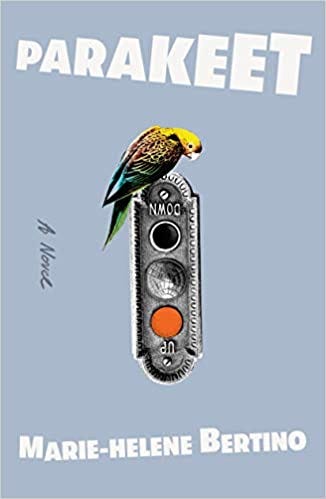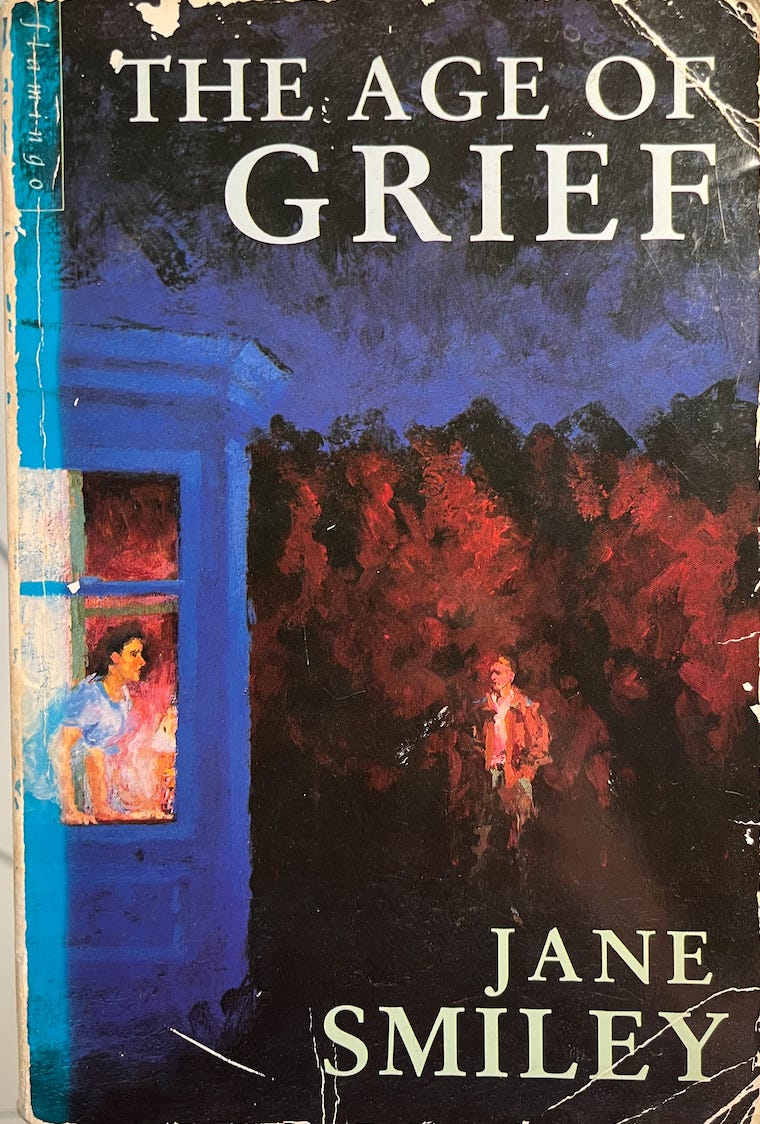Hi, I mostly wrote this roundup in September, and then never sent it. Embarrassing! I’d also started writing it months before that. If this doesn’t sum up 2021, I don’t know what does. But anyway, the book recs hold up, so let’s get this post out there and move on with our lives—hooray! Happy new year, and happy reading.👇👇👇
Annnnnnnnd, here’s the September post:
Hello, and good morning (or afternoon, or evening)! For no particular reason, today is the day I am sharing with you the newsletter I meant to send out one-to-two months ago, in no small part because this is also the day I am choosing to write this newsletter. It involves three books and many birds. In fact, it’s bird themed. Let’s flock.👇👇👇
Is there a better experience than stumbling upon a book that you didn’t consciously know existed, bringing it home, reading it, and loving it? If there is, please tell me, because that is very much a rhetorical question.
This past summer, that happened to me—twice! The first time, I had less than five minutes to supermarket-sweep my way through a bookstore. (I always think I’m early for things, make plans for all the extra time, and am then shocked that I miscalculated and have to rush.) There, Marie-Helene Bertino’s novel Parakeet caught my eye. I did a quick flap read, bought it, and got Judy the dog to her water therapy swimming appointment on time (DM for pics). That book is now this month’s “Current” selection and harbinger of the bird theme.
The second bout of luck was even more exciting because it happened on the $2 table outside a used bookstore in NYC. I was rushing to meet a friend, and when I got to Alabaster, the dreaded “Back in 5 minutes” sign was up. That left me with the bargain cart outside and, really, enough good finds that I wondered if the HBO Max intern had loaded it [<-- that joke was very funny when I wrote this]. One of those finds was The Age of Grief, by Jane Smiley.
The Age of Grief is not obviously about birds (nor is it unobviously about birds), but it was so in-my-tracks-stoppingly good, that I knew I was going to include it. And also(!), the version I have is from the Flamingo imprint of HarperCollins in the UK. So there you have it, perhaps it made subconscious sense all along.
Finally, the reason I chose a bird theme in the first place is hardly a subconscious secret to me. It’s clearly so I could humbly ask you to read one of my all-time favorites, Birds of America, by Lorrie Moore—and so that I could reread it, too. As far as recommendations go, it’s not really going out on a limb: It’s a GOAT book. (Is that a thing? Let’s make it a thing.)
If you haven’t read it, you’re in for a treat. If I could go back in time one time only, I would legitimately consider going back to the day I first flipped open Birds of America and started reading “Willing,” the first story in the collection.
So sit back, relax, and consider this transition some sort of migration metaphor.
CURRENT:
Parakeet, by Marie-Helene Bertino
June 2020 (Farrar, Straus and Giroux)
There tends to be a habit, in book reviewing, of tamping down enthusiasm. I imagine this practice comes from the fact that it can be scary to lay yourself bare: To reveal yourself as a fan of something, to show unbridled admiration, is to open your own self up for analysis and criticism.
In most aspects of life, it’s easier to couch, and I do it all the time—a regular ol’ human sofa over here. But sometimes, I find myself thinking, I just want to drink the Kool-Aid for once! The Kool-Aid of anything! So I’ve decided to help myself to a generously sized glass of Marie-Helene Bertino Kool-Aid.
Parakeet is a weird little book. And if you’ve read past Shirleys, you know “weird little book” is one of my favorite categories. Here’s the gist: The week of her wedding, a bride comes back to her hotel room to find a parakeet sitting there. It’s her dead grandmother. This alive bird/dead grandmother is hilarious, insightful, and cutting. She tells the bride not to get married, and instead, to find her estranged brother, who she hasn’t seen since he OD’ed on his own wedding day seven years prior. The bird then shits on her granddaughter’s wedding dress and flies away. The visit leads the bride on an adventure, both quotidian and surreal, which sees her seeking out her brother; coming to terms with how her brother used the defining, tragic event of her past for art; and grappling with the concept of marriage and “wife.”
I love a story that’s essentially a countdown: the days/hours/months leading up to a big event. It’s a simple and tight narrative structure that allows the heart of the story and its inherent oddities to shine, and it’s done just about perfectly here.
You’ll like it if you like...its lines:
“One week before my wedding day, upon returning to my hotel room with a tube of borrowed toothpaste, I find a small bird waiting inside the area called the antechamber and know within moments it is my grandmother. I recognize the glittering, hematite eyes, the expression of cunning disapproval. The odor of a gym at close of day encircles her. What is the Internet? the bird says, does not say.”
(Matter-of-fact writing grounding magical elements plus an internet gag? Sign me up.)
“I’ve come a week early to this inn on the shaft of Long Island to prepare for the transition from woman to wife, to do what the groom calls ‘decompress’ because ‘of late’ I’ve become a bit of a ‘nightmare.’ To break apart if necessary, but to do so properly, amid slatted pool chairs and conference coffee. I’m thirty-six, ethnically ambiguous, and hold an intense job I do not like… Everyone is thrilled I’m getting married. No one can believe I’ve found such a sweet man. Everyone adores the treats sold in this town that are hybrids of bagels and flatbread. Flagels.”
(Bertino has a gift for finding just the right juxtaposition that makes everything both more and less important, like in life… et voila!, pathos.)
“I have what people call an out-loud face, one that mimics others without realizing. It may be the generous, peat-colored eyebrows, or the phrase they make with my conversation-piece nose. Strangers ask, Are you confused? Or, comment: You’re having fun. What they mean is, I’m less good than others at hiding.”
(I enjoy this because it is perfect and also because it is something that personally resonates with me. Poker is not my game.)
CONTEMPORARY:
Birds of America, by Lorrie Moore
1998 (Vintage)
I suppose it’s a stretch to designate this book, at nearly 24 years old, as “contemporary.” But it doesn’t matter what category it’s in; just read it.
Inside, you’ll find 12 short stories that are equal parts hilarious and heartbreaking, with language that will continuously surprise and delight. So many writers I know would kill (figuratively…maybe?) to have the same facility for turns of phrase that Moore has; I am one of them.
I once read something that said Moore’s stories were so perfect, in a way that no one else seemed able to make their stories so perfect, that you would expect to find false bottoms and cheap narrative tricks when you go back to look at how they’re constructed. But they are really just that sound.
I tend to most like writing that’s full of humor and darkness—which is different than dark humor. The humor is all the lighter because it occurs within the dark places; the darkness is what creates it and lets it shine. This book is full of that. So are her others.
You’ll like it if you like...its lines:
“In her last picture, the camera had lingered at the hip, the naked hip, and even though it wasn’t her hip, she acquired a reputation for being willing.
‘You have the body,’ studio heads told her over lunch at Chasen’s.
She looked away. ‘Habeas corpus,’ she said, not smiling.
‘Pardon me?’ A hip that knew Latin. Christ.”
(These are the opening lines that won me over for life.)
“Of course, it had always been in the spring that she discovered her husband’s affairs. But the last one was years ago, and what did she care about all of that now? There had been a parade of flings—in the end, they’d made her laugh: Ha! Ha! Ha! Ha! Ha! Ha! Ha! Ha! Ha! Ha! Ha! Ha! Ha! Ha! Ha! Ha!
Ha! Ha! Ha! Ha! Ha! Ha! Ha! Ha! Ha! Ha! Ha! Ha!
Ha! Ha! Ha! Ha! Ha! Ha! Ha! Ha! Ha! Ha! Ha! Ha! Ha! Ha!”
(Ed note: This “Ha! Ha!”ing goes on for two full pages, which is nothing short of conceptually and visually delightful.)
“The mother is not a shopper. She hates to shop, is generally bad at it, though she does like a good sale. She cannot stroll meaningfully through anger, denial, grief, and acceptance. She goes straight to bargaining and stays there.”
(A dagger, with a “ha”—from “People Like That Are the Only People Here,” one of Moore’s most famous stories, in which a baby undergoes cancer treatment.)
Of Yore:
The Age of Grief, by Jane Smiley
1988 (Flamingo/HarperCollins)
This isn’t Smiley’s 1992 Pulitzer Prize–winning novel, A Thousand Acres. It also isn’t any of her other novels that were long- or short-listed for big prizes. But it is amazing. I hadn’t read Smiley before, and now that I have, my life is better.
The Age of Grief is made up of five short stories and the titular novella—the story of two married dentists and their home life with three young daughters, wherein the husband suspects the wife is having an affair but convinces himself that as long as she doesn’t tell him she is, it’ll all be fine. Then, a horrific flu tears through the entire family.
This is how I read the novella: first, with interest; then, with increasing interest; then, holding my breath for pretty much the last 20 pages.
You’ll like it if you like...its lines:
“Maybe he had thought he saw in her cool blondness some sort of astringent distance, and now he saw that between Dana and a desired object there was no distance allowed at all. Maybe he was dazzled by the neat blouses and the deft workmanship into not seeing the defiant, greedy stare. Maybe he saw only the established dentist, not the determined dental student, the stainless-steel blonde in the doorway of the classroom, radiating tensile strength like heat. Appearances aren’t deceiving, I think, but you have to know where to look.”
(That last line.)
“When I used to think of the word ‘confusion,’ I would think of a kind of gray mist, but that is not what confusion is. Confusion is perfect sight and perfect mystery at the same time. Confusion is seeing without knowing, as if the optic nerves were still attached but the hemispheres of the brain were parted. Desire is confusion vibrating in the tissues.”
(Yes.)
The other stories in the book, also killer.
Plus, this is a top 10 author photo:
And that’s it! But before you go, here’s a brief list of other bird books that could have just as easily made the list:
I Know Why the Caged Bird Sings, Maya Angelou (1969)
Bird by Bird, Anne Lamott (1995)
Your Duck Is My Duck, Deborah Eisenberg (2018)—(I really love Deborah Eisenberg and this is a very good book.)
“The Birds,” Daphne du Maurier (1952)—(You’re welcome, Alfred.)
The Witch of Blackbird Pond, Elizabeth George Spear (1958)
The Goldfinch, Donna Tart (2013)
H is for Hawk, Helen Macdonald (2014)








